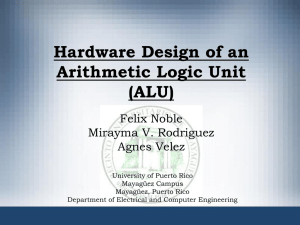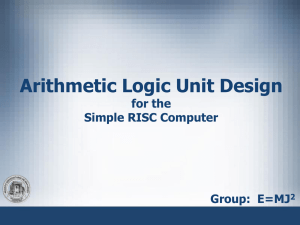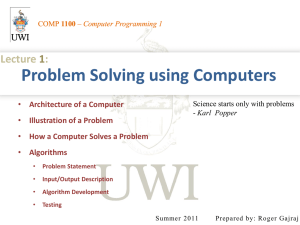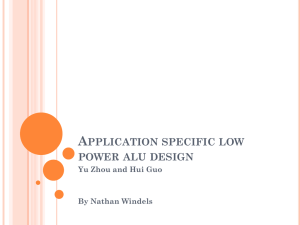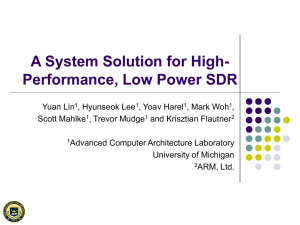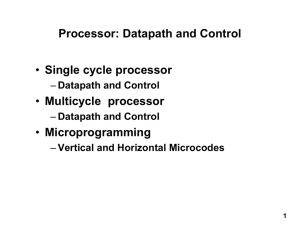ex - okstate-ecen4243-plp-spring-2011
advertisement
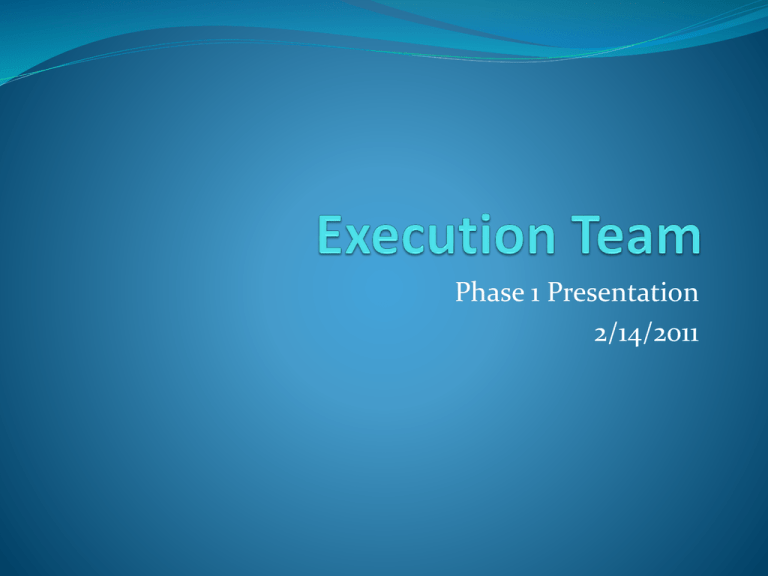
Phase 1 Presentation
2/14/2011
Wisdom of the Day
学而不思则罔,思而不学则殆
Learning without thought is
useless; thought without learning is
perilous.
Today we will encourage thoughts
while you learn about the execution
stage.
Confucius (551Bc-479BC) was
a Chinese thinker and social
philosopher whose teachings
and philosophy have deeply
influenced Chinese, Korean,
Japanese, and Vietnamese
thought and life.
Execution Engine Overview
Responsible for producing the
result of almost every instruction
Three design points:
The ALU
PC Manipulation
Memory Accesses
Block Diagram
Execute Stage Block Diagram
THE ALU
POWERHOUSE OF THE CPU
ALU Overview
The ALU is the main math unit of
the CPU
It takes two inputs and then
returns the results of various
operations on them
ALU Datapath
ALU Operations
Add (ADDU)
Set Less Than Unsigned
Subtract (SUBU)
(SLTU)
Shift Logical Left (SLL)
Shift Right Logical (SRL)
Load Upper Immediate
(LUI)
Or (OR)
And (AND)
Nor (NOR)
Set Less Than (SLT)
Addition
Uses a ripple carry adder to
produce the sum
Other options include a carry look
ahead adder
We believe the ripple carry adder
is sufficiently fast for our
implementation.
C Code
int ADDU(int a, int b){
return a+b;
}
Subtraction
Modified existing adder to handle
both Add and Subtract
Subtraction is the addition of one
number and the 2s compliment of
a second number
2s compliment: invert bits then
add 1
A-B = A + (B! + 1)
C Code
int SUBU(int a, int b){
return a-b;
}
Subtraction
For our adder to handle both Add
and Subtract, we place a mux in
front of the adder
Choice 1: signal unmodified
Choice 2: inverted part of B
Then to add one we set the carry in
bit of the adder to high
C Code
SUBU(int a, int b){
return a-b;
}
Set Less Than
On a set less than instruction, the
ALU determines if the first input is
less than the second.
To implement, we subtract the two
operands and then determine if
the output is negative.
The sign becomes the result.
1 means it is less than.
0 indcates that it is not.
C Code
boolean SLT(int a, int b){
return a<b;
}
Set Less Than Unsigned
First, let's try using the exact same
logic as SLT:
12<3?
12-3<0?
1100-0011 = 1100+1101 = 1001 = -7
We have determined this won't
work.
Ideas?
C Code
boolean SLTU(uint a, uint b){
return a<b;
}
Set Less Than Unsigned
Let’s add an extra zero to make
them positive
12<3?
12-3<0?
01100-00011 = 01100+11101 = 01001 = 9
This does work.
Sign bit is only the XOR of 0, 1 and
the last carry out bit.
If you're savvy, you'll notice this is
simply the NOT of the carry-out
bit.
C Code
boolean SLTU(uint a, uint b){
return a<b;
}
Shifting
The output bits choose their bit
based on the input shamt
Implemented using MUXes.
We made it faster by converting
shamt to one-hot encoding.
No cascading of MUXes
Uses a bunch of and gates in
parallel
Any ”leftover” bits are 0's.
C Code
uint SLL(uint a, int shamt){
return a<<shamt;
}
Logic Operations
AND
OR
NOR
In order to complete these
operations we use bitwise, AND,
OR, and NOR.
Uses 32 gates for each
operation.
C Code
int AND(int a, int b){
return a&b;
}
Load Upper Immediate
Returns the value of the
immediate shifted left 16 times.
Reusing SLL complicates the logic
of the ALU circuit.
Uses a dedicated 16-shift left
module.
C Code
int LUI(int a){
return a<<16;
}
ALU Control
How is the ALU controlled?
How can we accomplish this?
Alternative options?
ALU Control
Nearly every operation is computer
in parallel
When ADDU is performed, SUBU,
SLT and SLTU are not, and viceversa
There is a MUX inside the ALU
The MUX chooses the output
based on the requested operation
ALU Control
How was this accomplished?
One hot encoding
SIG0 is for indicating the adder
must do subtraction.
Operation
Code
SIG0
ADD
000000001
0
SUB
000000001
1
OR
000000010
0
AND
000000100
0
NOR
000001000
0
SLT
000010000
1
SLTU
000100000
1
SLL
001000000
0
SRL
010000000
0
LUI
100000000
0
ALU Control
Alternative Options
Binary Encoding
One Cold Encoding
We use one hot to make the MUX
less complex
Just as we did for the SLL and SRL
Immediates
Adding special instructions for
immediates would be painstaking
and wasteful
Determine second input from
outside the ALU
Immediate Datapath
PC Manipulation
MOVING ABOUT THE CODE
PC Manipulation Overview
Dynamic alteration of the PC
allows for programs to be nonlinear
Greatly increases the capability of
computers
Branching
Branch instructions modify the
program counter to skip over
sections of code or to go back to
repeat previous code.
Our branches allow for conditional
movement to an offset.
Conditional Branch
BEQ: Branches when the values in
the two registers are equal
BNE: Branches when the values in
the two registers aren’t equal
Two things must be calculated:
New address
Comparison
C Code
if(a == b) goto c; /* BEQ */
if(a != b) goto c; /* BNE */
Conditional Branch
Solution: dedicated adder to
calculate new address
The ALU can then do the
comparison
Extra output to determine if
subtraction results in a 0
C Code
if(a == b) goto c; /* BEQ */
if(a != b) goto c; /* BNE */
Branching Datapath
Jumping
Jumps unconditionally change the
PC
Their addresses are absolute
rather than offsets of the current
PC
C Code
goto c;
Jumps
Two unlinked jumps
Jump(J): jumps directly to the
instruction in the immediate field
Jump Register (JR): jumps to the
instruction whose location is the
value of the given register
C Code
goto 0xDEADBEEF; /* J */
goto c;
/* JR */
Jumping Datapath
Linked Jumps
Two linked jumps
Jump and Link(JAL): jumps to the
instruction in the immediate field
and saves the return address in $ra
Jump and Link Register (JALR):
jumps to the instruction in the
immediate field and saves the
return address in the specified
register
C Code
$ra = PC+8;
goto 0xDEADBEEF;
Linked Jumps
Linked jumps record the address
of PC+8
This is the instruction after the
delay slot instruction
More MUXes on the ALU inputs to
choose when return the link
address
C Code
$ra = PC+8;
goto 0xDEADBEEF;
Linked Jumping Datapath
PC Change Determination
PC will change on a successful
branch or a jump command
Use and a combination of AND
gates and an OR gate
Use JUMP? bit to choose the new
address
C Code
if(BEQ && !Not Zero || BNE &&
Not Zero || Jump){
goto NewAddress;
}
MEMORY INTERFACING
LOADING AND STORING
Memory Interfacing Overview
There are a limited number of
registers in the CPU
To maintain and obtain more data,
we need to be able to access a
larger pool of data
Load Word
Loads some word into a register
from memory
The address is determined by
adding an offset to the first
operand
Easily implemented in the ALU
C Code
b = mem[a+0x000016]
Store Word
Stores a register to memory
We use the same method as load
word to calculate the address
C Code
mem[a+0x000016] = b
Memory Datapath
Conclusion
Three design points:
ALU
PC Manipulation
Memory Accesses
Take advantage of repeated logic
If all else fails, more hardware
Questions
Works Cited
Confucius
http://www.all-famous-quotes.com/images/uploads/confucius1.jpg
Exeggutor
http://www.pokecommunity.com/signaturepics/sigpic136542_1.gif
Block Diagram
http://upload.wikimedia.org/wikipedia/commons/thumb/e/ea/MIPS_Architecture_%28Pipelined%29.svg/800px-MIPS_Architecture_%28Pipelined%29.svg.png
Doctor of Math
http://brownsharpie.courtneygibbons.org/?p=452
Flowchart
http://xkcd.com/210/
Bank Branch
http://media.glassdoor.com/m/7f/db/98/f9/a-typical-suntrust-bank-branch-this-one-located-at-4235-university-drive.jpg
Navy Seal
http://upload.wikimedia.org/wikipedia/commons/c/cf/NavySeal.png
One Tree Hill
http://gmovietrends.com/wp-content/uploads/2010/11/One-Tree-Hill.jpg
Van Halen
http://flavio.castelli.name/wp-content/uploads/2010/08/van-halen-jump.jpeg
Paratroopers
http://upload.wikimedia.org/wikipedia/commons/1/13/720th_Special_Tactics_Group_airmen_jump_20071003.jpg
Jumper
http://www.themovieblog.com/wp-content/uploads/2007/12/jumper-poster-2.jpg
Jumping Spider
http://fc03.deviantart.net/fs23/f/2007/356/1/a/green_jumping_spider_closeup_by_troypiggo.jpg
RAM Upgrade
http://farm1.static.flickr.com/145/329883185_6b80bde503.jpg
Battering Ram
http://4.bp.blogspot.com/_86fa3woQOHU/SwPiRaktsdI/AAAAAAAAA4c/pn35L4Ei7B8/s1600/BatteringRam.jpg
Tron Ram
http://obsoletegamer.com/wp-content/uploads/2010/03/RamMyBuddy300.jpg
Animal Ram
http://www.bigfoto.com/themes/nature/animals/ram-animal-i4t.jpg
Fry
http://scalp.plaxmol.com/wp-content/uploads/2009/02/fry-panique-questions.jpg

